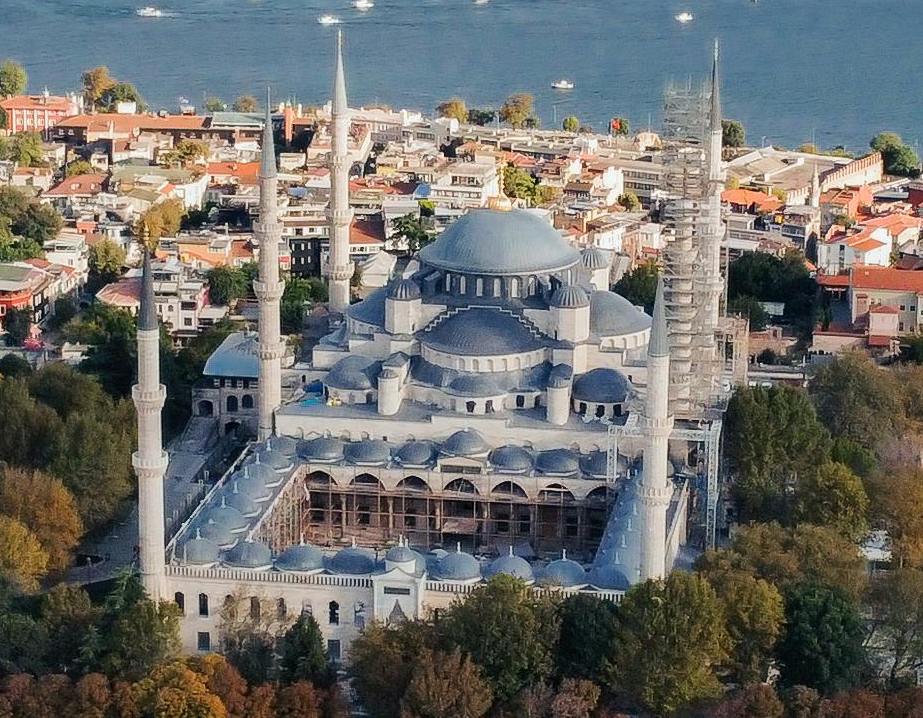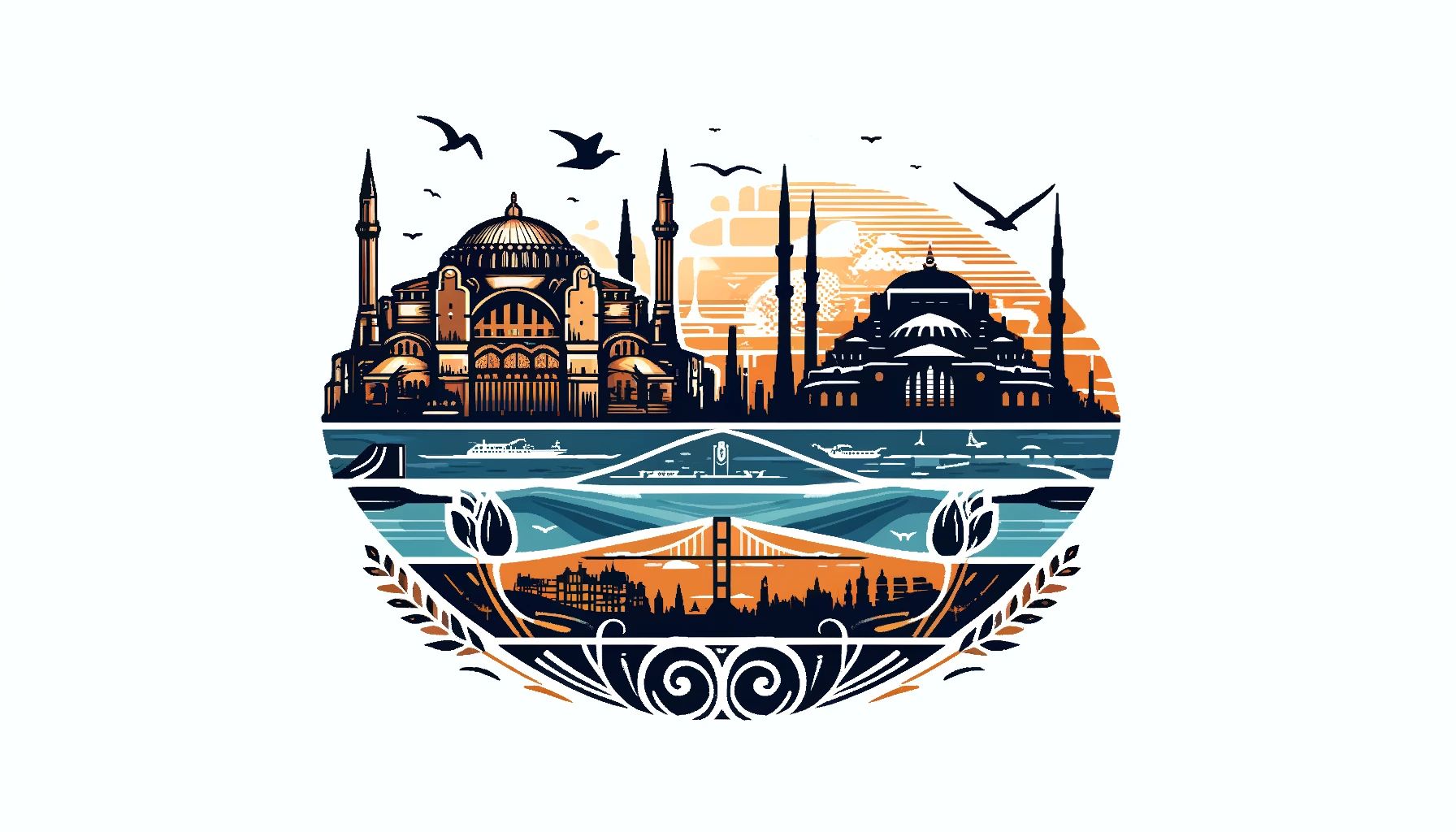The Blue Mosque, also known as the Sultan Ahmed Mosque, stands out in Istanbul for its beautiful blue tiles and unique six minarets. Built in 1609 by Sultan Ahmed I, it represents a masterpiece of Ottoman architecture. The mosque combines different architectural styles and intricate designs, capturing the interest of everyone who visits.

The Blue Mosque stands as a stunning example of Ottoman architecture, beautifully combining Islamic and Byzantine design elements. Completed in 1616 under the guidance of the architect Mehmet Ağa, it’s famed for its six tall minarets, layered domes, and the distinctive blue tiles that cover its walls. Its design and elegance draw inspiration from the historic Hagia Sophia, another of Istanbul’s architectural marvels.
The main dome, surrounded by smaller domes and half-domes, makes the inside spacious and balanced. The outside features a series of falling domes and slim towers that create a striking view against Istanbul’s skyline. The mosque’s name comes from the blue tiles that decorate it, which are detailed with flower designs and writings. Its courtyards with covered walkways, water fountains for washing, and large areas for prayer add to its beauty, making it a standout piece of Islamic architecture.

a famous Ottoman architect, was the mastermind behind the Blue Mosque, known for his skill in designing spaces that beautifully play with light and intricate details. Completed in 1616, the mosque still stands as a cultural highlight and a perfect example of the skilled craftsmanship of Ottoman builders.
1609: Construction began in 1609 under Sultan Ahmed I on a site that was once a hippodrome, symbolizing Ottoman strength. The first step was digging up the site and laying down large stone blocks to form a strong foundation for the massive mosque.
1610-1612: Once the foundation was set, the next focus was on building the walls and starting on the interior. They used a sturdy combination of bricks, stones, and wooden beams to build up the walls and shape the inside of the mosque.
1613-1614: In 1613, they started building the central dome, showing off Ottoman engineering skills. They put together a detailed structure made of wooden ribs, then covered it with lead to protect it from the weather. During this time, they also started constructing the six minarets, a standout feature of the mosque, designed to equal the number of minarets at the Prophet’s Mosque in Mecca.
1615-1616: With the main building almost done, the focus shifted to decorating the inside. Over 20,000 beautiful Iznik tiles, each hand-painted with detailed floral designs, were carefully placed, filling the interior with colors of blue, green, and turquoise.1617: The Blue Mosque was completed and opened to the public in 1617, marking a big moment in Ottoman history. The mosque’s stunning design and unique features showcased the empire’s lasting strength and cultural richness.
The exteriors of the Blue Mosque is a great example of Ottoman architecture, beautifully mixing Islamic and Byzantine styles. It’s well-known for its six tall minarets, which were unusual and caused quite a stir when they were built.
The walls are covered with stunning Iznik tiles that feature bright blue designs, flowers, and fancy writing, giving the Blue Mosque its name. The main entrance has a big courtyard with arched walkways leading to the area where people pray. The slender minarets, topped with pointy caps and featuring balconies, add a graceful touch to Istanbul’s skyline.
Together, these elements form a beautiful architectural display, showing off the skill of Mehmet Ağa and his plan for the Sultanahmet Mosque. This mosque is not just a place to pray but also a timeless piece of art in the heart of Istanbul.
The inside of the Blue Mosque is a wonderful example of architecture, with a big prayer hall that is beautifully decorated.
The main dome, supported by smaller domes and semi-domes, makes the inside feel grand and spacious. The ceilings and walls are covered with stunning blue Iznik tiles that have detailed flower designs and fancy writing, adding to the mosque’s unique look. The mihrab of the Blue Mosque, which shows the direction to Mecca, is beautifully detailed and a main attraction. Nearby, the minbar, or pulpit, displays excellent craftsmanship with its geometric designs. Big stained glass windows let in lots of natural light, showing off the mosque’s detailed designs. The design mixes beauty with function, creating a peaceful and uplifting space.
The Blue Mosque’s design was inspired by the Hagia Sophia, an old Byzantine building. It was made to look good alongside the Hagia Sophia from a distance and features detailed patterns and shapes that are both symmetrical and geometric.
Mehmet Aga, a famous Ottoman architect known for his great work with light and design, created the Blue Mosque. His ideas and skills made the detailed designs of the mosque possible.
The Blue Mosque is known for its large central dome, which is 23.5 meters across and 43 meters high, its six minarets, and over 20,000 hand-painted Iznik tiles with floral and written designs that cover both inside and outside.
Mehmet Aga was inspired by the design of Hagia Sophia and the dome and minarets of the Selimiye Mosque when he planned the Blue Mosque.
The building of the Blue Mosque started in 1609 and finished in 1616, during Sultan Ahmed I’s rule.
It took about seven years, from 1609 to 1616, to build the Blue Mosque. This time was used for careful planning and building, with Mehmet Aga leading the construction.
The Blue Mosque is known for its big dome, six minarets, and beautiful Iznik tiles. These features show a mix of Byzantine, Seljuk, and Ottoman architectural styles.
The outside of the Blue Mosque has a big courtyard, a grand entrance, six thin minarets, and a dome-shaped roofline. The lower walls outside are covered with colorful Iznik tiles.
The entrance and inside of the Blue Mosque are decorated with hand-made Iznik tiles that are mostly blue with touches of red, green, and gold. The mosque is named after these famous blue tiles.
Yes, the Blue Mosque is a great example of Islamic architecture. It has beautiful tilework and stained glass windows. The tiles show traditional patterns like trees, flowers, and fruits which were specially chosen by Sultan Ahmet for this mosque.
Yes, the Blue Mosque is well-known for its stunning blue Iznik tiles, which are made in the Turkish city of Iznik. These tiles are painted by hand with flower designs and beautiful writing, making the inside look amazing.
The inside of the Blue Mosque has a mix of Ottoman and Byzantine styles with blue, green, red, and gold Iznik tiles. It’s filled with art from the Ottoman period and also includes some 20th-century art.
The Blue Mosque is a famous building in Ottoman architecture that draws many tourists. It has a traditional Ottoman design with a big dome surrounded by smaller domes, a large courtyard, and six tall minarets.
